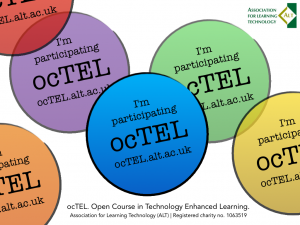- Firstly … yes, I know the ‘error’ in the title! This one is called ‘Week 1 …’, and so was the last one: “Week 1: Induction #ocTEL”. I made a mistake, last week. While last week was technically the first week of the MOOC it was not assigned a numerical identity as it was the orientation / induction week. That’s why, if you’re reading this MOOC series back there are two ‘week 1′ posts!
I want to continue the style I started in my previous post by highlighting each activity as the ocTEL website/email introduces us to it …
… and I start with an confesison. I think I’m all read out. I’ve been reading so much recently, and with Inge Ignatia de Waard’s ‘MOOC Yourself’ (2013) book just added to the list, I’ve had enough. So this week I’ve taken some time ‘off’ and just done the bare minimum.
Activity 1.0: “If you only do one thing … “
Deciding on two of these resources to concentrate on was easy. Do I review Helen Keegan’s PELeCON keynote that I loved at last year’s pelc12 event because (a) I was in the audience during the recording and remember the gasps from the audience as we realised how risky and brave she’d been throughout the project, and (b) enjoyed the whole ARG-thing. Do I look into the ‘technology of touch‘ and the work of haptic technology that enables learning in a safe tactile environment? I want to stay away from something I’m familiar with (so that drops Sugata Mitra off the list, I’ve blogged about this work too), so that leave Eric Mazur and Stephen Downes / George Siemens references.
Eric Mazur, talking about peer instruction (three minutes from where the below video starts) is not familiar to me. Eric talks of the ‘ah ha’ moment that happens outside the classroom, and which is the hard part of ‘learning’ – is it the “information transfer” or the “assimilation of knowledge”?
YouTube: Eric Mazur “The scientific approach to teaching…”
By concentrating on the easiest of the two elements of learning, the information transfer, we leave the students to fend for themselves for the reflection and “assimilation” of knowledge – this isn’t right, as this is as important, if not more so, than the actual initial introduction of the information. By throwing out this initial stage of learning, by replacing the lecture with a recorded lecture the students watch before the session he has been able to introduce discussion and questioning to the learning process where there wasn’t time or inclination before. Is this better learning, or just a better method for presenting the opportunity to learn?
And what of George Siemnes and Stephen Downes? I follow their work on Twitter, whenever possible, and their continued development of a sustainable and ‘appropriate’ MOOC pedagogy. From a student-centred constructitivst approach where the institution makes the content and process of learning available (the ‘open’ in the MOOC acronym) and the students create their own spaces (like ocTEL and EDC MOOC) to publish their opinions and openly discuss them. I like and am comfortable with this approach as it is a space I can ‘learn’ in – I figured out very quickly during my undergraduate days (mid 1990′s) that I didn’t learn in a lecture theatre, that I didn’t like being talked ‘at’ and that I’m a kinesthetic learner (Characteristics of a Tactile/Kinesthetic Learner) – I need to follow the materials, stop, restart, write, stand up, move around, note take, draw, go away and come back and do some more. The movement helps me form the connections between p paragraphs, pages, links, chapters, etc.
Perhaps this is why I like (at the same time I don’t like) the approach made to this MOOC – I can come and go as I please, with whatever time or inclination I can commit. I’m not tied to a defined ‘lecture’ period at a specific time: I like and want to learn in an asynchronous manner. But that doesn’t mean I can do everything I want to, or am expected to … which is why this week this is all I’m doing. I am reading the rest of the material, I may even write about it later, but not now.
Next week … “Understanding learners’ needs”.
Reference
Characteristics of a Tactile/Kinesthetic Learner. Lehigh University. n.d. http://www.lehigh.edu/~inacsup/cas/pdfs/LS_Tactile_Learner.pdf
de Waard, I. I. 2013 MOOC YourSelf - Set up your own MOOC for Business, Non-Profits, and Informal Communities [Kindle eBook]. http://www.amazon.co.uk/MOOC-YourSelf-Non-Profits-Communities-ebook/dp/B00CDVZ2AW/



